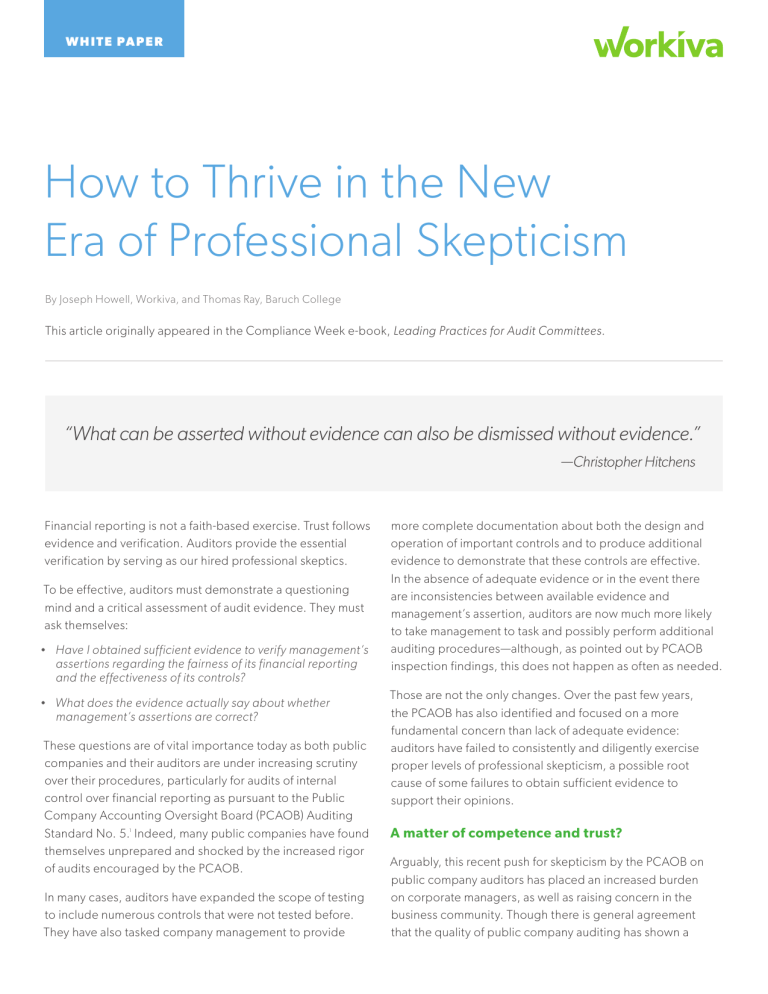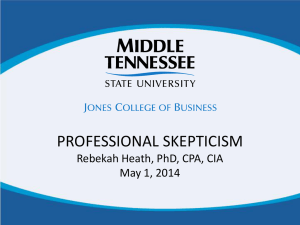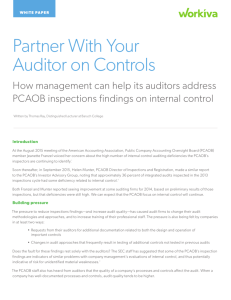How to Thrive in the New Era of Professional Skepticism

WH ITE PAPE R
How to Thrive in the New
Era of Professional Skepticism
By Joseph Howell, Workiva, and Thomas Ray, Baruch College
This article originally appeared in the Compliance Week e-book, Leading Practices for Audit Committees.
“What can be asserted without evidence can also be dismissed without evidence.”
—Christopher Hitchens
Financial reporting is not a faith-based exercise. Trust follows evidence and verification. Auditors provide the essential verification by serving as our hired professional skeptics.
To be effective, auditors must demonstrate a questioning mind and a critical assessment of audit evidence. They must ask themselves:
• Have I obtained sufficient evidence to verify management’s assertions regarding the fairness of its financial reporting and the effectiveness of its controls?
• What does the evidence actually say about whether management’s assertions are correct?
These questions are of vital importance today as both public companies and their auditors are under increasing scrutiny over their procedures, particularly for audits of internal control over financial reporting as pursuant to the Public
Company Accounting Oversight Board (PCAOB) Auditing
Standard No. 5.
1
Indeed, many public companies have found themselves unprepared and shocked by the increased rigor of audits encouraged by the PCAOB.
In many cases, auditors have expanded the scope of testing to include numerous controls that were not tested before.
They have also tasked company management to provide more complete documentation about both the design and operation of important controls and to produce additional evidence to demonstrate that these controls are effective.
In the absence of adequate evidence or in the event there are inconsistencies between available evidence and management’s assertion, auditors are now much more likely to take management to task and possibly perform additional auditing procedures—although, as pointed out by PCAOB inspection findings, this does not happen as often as needed.
Those are not the only changes. Over the past few years, the PCAOB has also identified and focused on a more fundamental concern than lack of adequate evidence: auditors have failed to consistently and diligently exercise proper levels of professional skepticism, a possible root cause of some failures to obtain sufficient evidence to support their opinions.
A matter of competence and trust?
Arguably, this recent push for skepticism by the PCAOB on public company auditors has placed an increased burden on corporate managers, as well as raising concern in the business community. Though there is general agreement that the quality of public company auditing has shown a
needed improvement since the Sarbanes-Oxley Act of 2002
(SOX), which established the PCAOB, some critics are openly questioning whether the PCAOB has gone too far, resulting in unnecessary and even counterproductive audit work.
analyses or management’s explanations without obtaining evidence to corroborate management’s assertions, as well as insufficient testing of the completeness and accuracy of source documents.
In May 2015, the U.S. Chamber of Commerce’s Center for
Capital Markets Competitiveness (CCMC) specifically raised these concerns in a letter to PCAOB Chairman James Doty, and James Schnurr, the Security and Exchange Commission’s
(SEC) Chief Accountant, and requested a meeting with stakeholders to discuss the issues.
2
One of the letter’s themes is that public company auditors should be able to rely more on the competence of the persons performing the audit, along with the strength of other aspects of the company’s internal controls, such as the control environment and risk assessment, when deciding whether a specific control activity is effective. In other words, auditors should put more trust in management and the process.
However, exercising sufficient skepticism is easier said than done. In fact, the PCAOB recognizes that there are some powerful impediments to exercising professional skepticism.
These include incentives and pressures to build and maintain a long-term audit engagement, avoid significant conflicts with management, provide an unqualified audit opinion prior to the issuer’s filing deadline, and/or cross-sell other services.
Over time, auditors can also develop an inappropriate level of trust or confidence in management, feelings of pressure to avoid potential negative interactions with or consequences to, individuals they know (that is, management), and can struggle with scheduling and workload demands.
The problem is that trust without evidence remains an act of faith.
Skepticism is here to stay
How likely is the PCAOB to ease up on its call for increased skepticism? Not very.
In December 2012, the PCAOB published its Staff Audit
Practice Alert No. 10, “Maintaining and Applying Professional
Skepticism in Audits.” 3 Based on inspection findings, the staff expressed concern and offered an in-depth discussion regarding auditors’ obligations to remain skeptical throughout an audit. In addition, it offered numerous examples of how auditors can improve and maintain the appropriate attitude.
The Sarbanes-Oxley Act and the Foreign Corrupt Practices
Act of 1977 obligate companies, not their auditors, to design, implement, and maintain effective internal control systems.
SOX also requires that company executives take individual responsibility for evaluating the effectiveness of their internal control over financial reporting and report any weaknesses.
The following year the Board issued a summary inspection report (2013), which identified insufficient skepticism as one of several “root causes” of audit deficiencies.
4
Its conclusion was consistent with the findings from a similar
PCAOB inspection report published in 2008. More recently, author Thomas Ray reviewed the issue in a article, “Auditors
Still Challenged by Professional Skepticism,” in The CPA
Journal , noting that auditors continue to be criticized for not exercising an adequate level of professional skepticism, which is essential for an effective and reliable audit.
5
The issue remains an active discussion point for PCAOB board members and senior staff in their public comments and speeches—and for good reason. According to the PCAOB, the lack of professional skepticism tends to manifest itself in—among other things—acceptance of client-prepared
Accordingly, the PCAOB and others continue to urge and instruct auditors how to better maintain their skeptics’ edge, and their efforts appear to be working. The result is that auditors are performing more auditing work, which manifests itself in numerous ways. These include increasing the scope of work (e.g., visiting more company locations, auditing more and smaller balances and transactions), identifying and testing process-level controls instead of limiting their efforts to higher-level management review controls, and obtaining evidence that is more reliable.
If you can’t beat ‘em, join ‘em
Unfortunately, not all companies have done an adequate job of fulfilling these obligations. As Brian T. Croteau, Deputy
Chief Accountant for the SEC, pointedly stated in a December
2014 speech, “… based upon our cumulative efforts this year, I continue to question whether material weaknesses are being properly identified, evaluated, and disclosed.”
6
Surely, management must be objective when designing, implementing, and evaluating the effectiveness of its internal control systems. Perhaps management should take a cue from its auditor counterparts and become more skeptical, particularly as it relates to the procedures performed by company personnel in evaluating effectiveness and the
adequacy of the evidence obtained and documented supporting management’s assessment. We believe that such levels of skepticism could be equally, if not more important, for financial managers.
Exercising appropriate skepticism becomes even more important as the size of the company increases and the performance and evaluation of controls is delegated throughout the organization. Dear CEO and CFO, how is it that you are satisfied that your controls are effective and that sufficient evidence has been obtained to support your written assessment?
Whether you’re ready to embrace it or not, there’s one thing you can be sure of: regulators and inspectors will continue to put pressure on auditors and their clients to be skeptical and forthright, obtain sufficient evidence, and to improve their internal control assessment.
Key considerations for survival in a skeptical world
Arguably, forward-looking managers will get ahead of their auditors’ demands for more compelling evidence of control and compliance. To do this, they need to seek out and deploy tools and processes that enable their organizations to collect and manage the evidence they need in more costeffective, timely, thorough, and less error-prone ways. In our experience, we have identified a number of considerations that will improve the effectiveness of management’s process.
1. Establish a single source of truth for critical information
about risks, controls, and compliance
Information stored across many locations or even in a shared network drive poses challenges for many companies. A shared network drive provides a single location to store the information. But if important facts are stored or processed in different files and applications, it quickly becomes a nightmare trying to make sure that all of the representations of a key fact are identical and keeping track of which version is correct if they are not.
Most SOX and internal control teams create multiple versions of risk assessments and control processes that are shared via email and stored on shared network drives. The information in these files is often inconsistent, out of date, or incorrect as the team battles version control issues and discrepancies between narratives, flowcharts, and spreadsheets.
To combat this issue, managers can leverage a number of commercially available technologies. These solutions enable companies to design and implement simple, yet powerful, single source of truth environments by allowing users to collaborate in one environment, using content seamlessly across all documents.
2. Ensure that supporting documentation is consistent by
linking it directly to that single source of truth
For most companies, the current process of maintaining consistency between multiple references to the same information about risks, controls, and compliance is managed by human memory and typing skills. As a practical matter, it’s nearly impossible to avoid mistakes when working with tens, hundreds, or thousands of references.
Companies commonly experience this pain with control processes that are discussed in a wide range of documents, including narratives, flowcharts, and spreadsheets. Human error causes discrepancies and conflicting information in these documents.
Managers, don’t leave decisions that are susceptible to human error. Implement a solution that links information between documents, so when an update is made at the source, that change is propagated across all documents and all locations.
3. Provide simple, intuitive vehicles to help control owners
remember and follow critical control procedures
Sometimes control owners don’t perform management review controls completely and accurately. Most companies rely on the professional training and memories of their control owners and managers to perform critical management review controls.
However, human memories are challenged when remembering complex processes.
To alleviate this issue, make sure that the design of the control is well documented, and provide the control operator with a checklist or program related to its operation. The design document should include matters such as the objective of the control, its precision (the size of error it is designed to detect or prevent), how the control works, sources of information needed to perform the control and information about the nature and reliability of that information (for example, whether it is system-generated, is developed by other company employees, and whether there are controls in place to ensure its completeness and reliability).
The checklist or program would assist managers in remembering and documenting all of the critical steps taken, such as:
• Reviewing supporting information for completeness and reliability
• Evaluating whether evidence is sufficient and whether it supports significant assumptions and inputs
• Checking calculations for accuracy and consistency with policy and GAAP
• Evaluating and resolving outliers or exceptions
• Concluding on the overall result
4. Capture evidence of compliance concurrent
with performance
Companies frequently collect signatures as evidence of key management review controls but sometimes fail to collect other evidence of the event or transaction until days, weeks, or months after the fact—making it difficult to obtain such evidence and sometimes leaving evidence gaps. For example, a manager signs a schedule prepared to support financial statement amounts, but provides no other detail about what that review included. Or, management meets to review results, but it does not prepare or retain an agenda, meeting minutes, or other evidence that the meeting occurred, what it covered, and what conclusions were reached.
Building on the previous recommendation, the process can be designed to capture essential information about the control operation concurrent with its performance.
5. Consider the design of the underlying accounting process
Sometimes the line between the accounting process itself, such as the development of an accounting estimate, and the operation of the control intended to assure that the estimate is reasonable, is difficult to discern. This can be especially true in the case of significant unusual transactions or events that occur infrequently. Similar to routine transactions, significant unusual transactions also need to have controls over them.
To facilitate the effective operation of the management review controls over such transactions or events, it is helpful to design a process that includes contemporaneously obtaining and documenting matters such as:
• The significant assumptions made and the evidence obtained regarding the appropriateness of the assumptions
• Information from outside the organization that can be relied on or should be considered, and that can be made available to the auditor
• Rationale as to why the estimation method used is appropriate
• Key aspects of contracts and other transactionrelated documents
• Information about the transaction or event that was shared with the board of directors and when such discussion(s) occurred
• Direction provided by the Board, follow-up actions taken, and decisions made
Concurrently obtaining and documenting evidence during the process, transaction, or event will help to assure management that it has the necessary information to support its decision making and the operations of its controls. It will also make it easier for the auditor to obtain the evidence needed for the audit.
It’s up to you
The law, rules, standards, and interpretive guidance are clear: company management has a responsibility to implement internal control to provide reasonable assurance of detecting and or preventing material misstatement of its financial statements on a timely basis. This responsibility is not a faith-based exercise, but rather based on providing verifiable evidence that demonstrates the effectiveness of control to auditors who serve as our professional skeptics.
Over the last decade and in response to past abuses of trust, regulators have raised the evidentiary bar for public companies and admonished their auditors, who serve the public trust, to exercise greater skepticism. Their actions have arguably placed an increased burden on management and continue to generate controversy in business community.
Though the debate on where to draw line on this so-called skepticism will no doubt continue, the trend toward evidence-based risk management is unstoppable, and the line will likely be drawn further than many managers would prefer.
Fortunately, management has options that will enable it to not only to survive, but to thrive in this brave new world of skeptics. It can begin by adopting a healthy level of skepticism and availing itself of the latest tools and processes to make its job manageable.
About the authors
Thomas Ray is a Distinguished Lecturer in the Stan Ross
Department of Accountancy at Baruch College, City
University of New York. Previously, Tom served as the Chief
Auditor and Director of Professional Standards at the Public
Company Accounting Oversight Board (PCAOB), where he oversaw the development of Auditing Standard No. 5 and numerous other PCAOB standards and rules. Tom also previously was Director-Audit and Attest Standards at the
American Institute of Certified Public Accountants, partner and Audit Group Head in the Department of Professional
Practice with KPMG LLP, and a member of the Advisory
Council of the Committee of Sponsoring Organizations
(COSO) of the Treadway Commission. He is a certified public accountant, received a BBA in accounting from the University of Wisconsin-Madison, and started his career with Grant
Thornton LLP.
Joseph Howell is Co-Founder and Executive Vice President of Workiva, which created Wdesk, a cloud-based productivity platform for enterprises to collect, link, report, and analyze business data with control and accountability. Prior to founding Workiva, Joe served as Chief Financial Officer of three public companies: Borland, EMusic.com, and Merix.
Resources
1
”Auditing Standard No. 5.” (2007). Public Company Accounting Oversight Board.
Retrieved from http://pcaobus.org/Standards/Auditing/Pages/Auditing_Standard_5.aspx
2
Quaadman, T. (2015). Center for Capital Markets Competitiveness. Retrieved from http://www.centerforcapitalmarkets.com/wp-content/uploads/2015/05/2015-5.28-Letterto-SEC-and-PCAOB.pdf
3
”Staff Audit Practice Alert #10.” (2007). Public Company Accounting Oversight Board.
Retrieved from http://pcaobus.org/standards/qanda/12-04-2012_sapa_10.pdf
4
”Report on 2007–2010 Inspections of Domestic Firms That Audit 100 or Fewer Public
Companies.” (2013). Public Company Accounting Oversight Board. Retrieved from http://pcaobus.org/Inspections/Documents/02252013_Release_2013_001.pdf
5
Ray, Thomas. “Auditors Still Challenged by Professional Skepticism.” (2015). The CPA Journal .
Retrieved from http://viewer.zmags.com/publication/8df8c3b9#/8df8c3b9/22
6
Croteau, Brian. “Remarks Before the 2014 AICPA National Conference on Current SEC and
PCAOB Developments.” (2014). U.S. Securities and Exchange Commission. Retrieved from http://www.sec.gov/News/Speech/Detail/Speech/1370543616539
The information contained herein is proprietary to Workiva and cannot be copied, published, or distributed without the express prior written consent of Workiva © 2015.
wp0815 workiva.com
info@workiva.com
+1.888.275.3125








